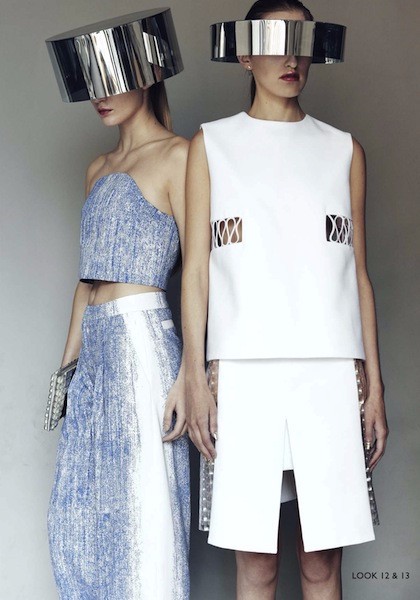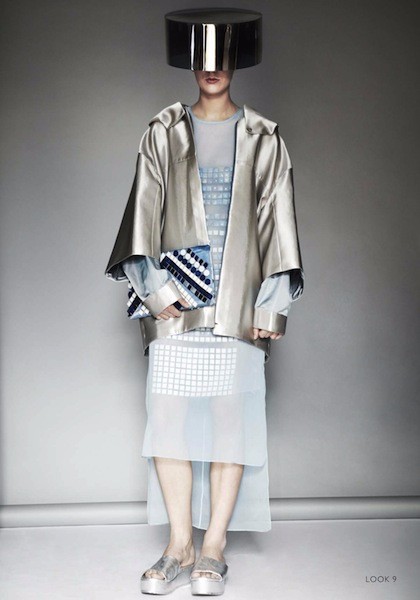Jamie Wei Huang is a young cutting-edge fashion designer with a degree in Fashion Design Womenswear from Central Saint Martins. The 28-year-old is originally from Taiwan, but is currently based in London where she interned with Alexander McQueen and Christopher Kane. She recently founded her eponymous label after having been selected as one of the top five finalists for the Designer for Tomorrow competition and showing her SS14 collection at Mercedes Benz Fashion Week Berlin in July 2013. Huang’s Spring / Summer 2014 womenswear collection features 10 highly conceptual looks that combine futuristic shapes and elements, simple yet refined cuts and traditional ‘ancient’ materials such as ceramic and glass. This conceptual, eclectic approach of mixing thin, fine fabrics such as jersey and silk with solid handcrafted materials like ceramics, glass and mirrors comes from Huang’s background in fine art.
Jamie, you have a background in fine art and you are still very active in the art scene. In 2009, you were selected as the artistic representative for the Société Nationale des Beaux Arts at the Louvre and you won the Medaille de Bronze at Le Salon 2012 Société des Artistes Francais. Why did you choose a career as a fashion designer?
For me, there is no difference between fashion and art. In fashion I also create a sort of sculpture, but I just use different materials. My background in fine art brings a certain conceptual idea to my collections and to the style that I like. Sometimes it’s hard to understand contemporary art and to get the message behind it. I think that, for me, it is easier to connect to the viewer and to convey my ideas and my concepts to them through fashion.
What’s the idea behind your SS14 collection?
I developed my SS14 collection from the concept of Op Art working with metallic fabrics and geometric shapes. The colour palette is based on white with a dash of red, orange and blue. The basic idea was to create futuristic, yet simple silhouettes. I also used traditional ancient materials, such as glass and ceramic, that have existed for thousands of years. As you can see, my idea of futuristic design combines heritage, art and technology. It’s not the sci-fi high tech kind of design that you know from sci-fi movies. I think that the concept of what people perceive as ‘futuristic’ is constantly changing. For people 20 years ago plastic and industrial factory-made fabrics were the future materials. Nowadays people appreciate vintage, hand-stitched and natural fabrics. When I was designing the SS14 collection, I tried to think about what people will be wearing in 20 years and maintain a spirit of traditional craftsmanship.
What about the helmets that appear in your SS14 collection? What was the idea behind these headpieces and what do they express? Did you design them especially for the show or could you imagine someone walking the streets wearing one of them?
The idea was to cover models’ faces in order to draw the viewer’s attention to the garment. I wanted to give the viewer the opportunity to imagine what kind of woman could actually wear my collection and how this woman might look. My intention was to make the helmets appear as a piece of metal and as a mirror. Seen from outside, they reflect the space and the objects around them, but allow to see through from the inside out. I designed the helmets especially for the show, but since my collection is a futuristic collection, I could definitely imagine people wearing such headpieces as part of daily wear some time in the future, maybe in 20 years…
Can you please describe your work. What is so special about it? How do you distinguish yourself from other designers?
My work is very conceptional and I consider it both fashion design and art. In a way, I create wearable sculptures. I’m using glass and ceramic in my designs and it’s very difficult to work with these materials. I usually combine them with very thin fabrics such as jersey and organza for contrasting effects. I could use plastic instead and it would look the same, but I like to feel the heaviness and the texture of these materials when I touch them. Of course this means that the items I design are less wearable and have less commercial appeal compared to more mainstream stuff and this also means that I’m losing some potential customers. I’m conscious about this point and about the consequences that I might have when I enter the fashion market. But my concept is a very important part of my design and I would like to keep it that way. I would rather develop a few other pieces by using different kinds of materials than abandon my principles. This is what makes me different from other designers.
What is your philosophy?
Believe in what you do and convince people to accept it.
Do you have a favorite item in your closet?
It is my mom’s trousers that she wore when she was 18. They look similar to the pleated trousers that I designed for my SS14 collection: white high-waist pleated trousers with stripes.
Please complete the sentence: I never leave my house without…?
My phone and my cigarettes.
Interview: Veronika Dorosheva











